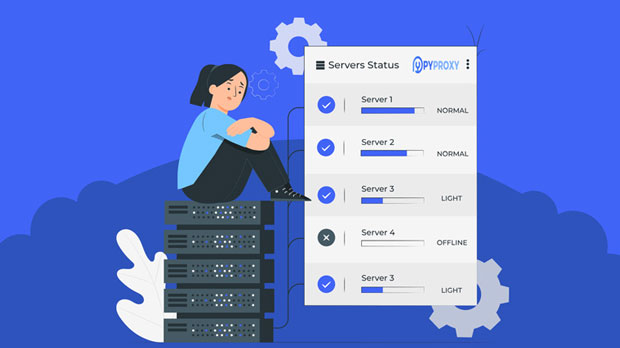How to ensure data transmission encryption and security when using SOCKS5 residential proxy?
In today's information age, the security and privacy protection of the Internet have become the top priority of individual and enterprise users. socks5 proxy, as a common proxy protocol, has been widely used in anonymous browsing, data crawling, and other network activities due to its support for multiple network protocols and higher flexibility. However, although SOCKS5 proxy provides anonymization services, it does not natively encrypt data transmission, which means that users' network traffic may still be subject to monitoring, data theft, or other forms of attacks. Therefore, ensuring data transmission encryption and security when using SOCKS5 residential agents has become an important task for users in protecting privacy and data securityWe will delve into how to ensure encryption and security of data transmission when using SOCKS5 residential agents. The article will start with the basic characteristics of the SOCKS5 protocol, analyze its security and privacy protection mechanisms, and discuss how to enhance the security of data transmission by using additional encryption tools, optimizing network configuration, and selecting high-quality proxy service providers. Through this series of methods, users can maximize the security and privacy protection of their data when using SOCKS5 proxyI. Basic Overview and Security Risks of SOCKS5 Protocol Before delving into how to ensure the security of SOCKS5 residential agents, it is necessary to first understand the basic concepts and working principles of the SOCKS5 protocol. SOCKS (Socket Secure) protocol is a network protocol used to transmit network traffic between clients and target servers through proxy servers. It does not care about the type of data being transmitted, so it can support almost all network protocols (such as TCP, UDP, etc.)SOCKS5 is the fifth version of the SOCKS protocol, which has stronger functionality compared to previous versions. For example, SOCKS5 supports username and password authentication, IPv6 address support, and a wider range of protocol transmissions. These features make SOCKS5 proxy a widely used proxy protocol in various network environmentsHowever, despite the obvious advantages of SOCKS5 protocol in flexibility and performance, its shortcomings in data encryption cannot be ignored. The SOCKS5 protocol itself does not encrypt the transmitted data, which means that all data streams transmitted through socks5 proxies can be intercepted and monitored, especially when using open or insecure networks. At this point, without additional encryption measures, data is vulnerable to security threats such as man in the middle attacks (MITM), sniffing, or eavesdroppingII. Advantages and Risks of SOCKS5 Residential AgencyWhen using SOCKS5 residential agents, there are unique advantages and potential security risks. In order to better understand how to ensure the security of data transmission, we first analyze the characteristics of SOCKS5 residential agents1. Advantages of SOCKS5 Residential AgencyCompared to regular SOCKS5 agents, SOCKS5 residential agents have higher privacy protection and security. Due to the fact that residential agents use actual residential IP addresses instead of virtual IP addresses from data centers, users are often difficult to track when using them. This makes residential agents more advantageous in terms of anonymity and anti detection capabilities, especially for users who need to avoid IP blocking or geographical location restrictions, such as cross-border data crawling, automated testing, etcIn addition, SOCKS5 residential proxies are able to flexibly handle various types of network requests, including proxies for TCP and UDP traffic, providing users with higher degrees of freedom and compatibility2. Risks of SOCKS5 Residential AgencyAlthough SOCKS5 residential agents have many advantages, their security risks cannot be ignored. Firstly, the SOCKS5 protocol itself lacks a data encryption mechanism, which means that even if a residential proxy is used, users' sensitive data may still be leaked or tampered with during transmission. Secondly, if the SOCKS5 residential proxy service provider used is unreliable, the user's IP address may be exposed and even become a target for malicious attackers. Even worse, criminals may disguise themselves as legitimate proxy service providers, inducing users to connect to malicious proxy servers and obtain sensitive user dataIII. Ways to Ensure Encryption and Security of SOCKS5 Residential Proxy Data TransmissionIn order to ensure the encryption and security of data transmission when using SOCKS5 residential proxy, users need to take a series of measures to prevent potential network attacks and data leaks. Here are some key steps and strategies:1. Using encryption protocolsSince SOCKS5 itself does not encrypt data, the most direct way to ensure data security is to use encryption protocols such as SSL/TLS. By combining SOCKS5 proxy with encrypted tunnels, users can ensure the security of data during transmissionCombining VPN with SOCKS5A common practice is to combine VPN (Virtual Private Network) with SOCKS5 proxy. VPN can establish an encrypted channel between users and proxy servers, effectively protecting data privacy and security. Through VPN encryption, all data that passes through SOCKS5 proxy will be encrypted to prevent third-party theft or tamperingEncryption tunneling technologyIn addition to VPN, there are other encryption tunneling technologies such as SSH tunneling. SSH (Secure Shell Protocol) tunnels can transmit data from local devices to remote servers through encryption and forward it through SOCKS5 proxies. Similar to VPN, SSH tunnels can provide encryption protection for SOCKS5 proxies, ensuring data confidentiality2. Choose a high-quality SOCKS5 proxy service providerChoosing a high-quality SOCKS5 residential proxy service provider is another key factor in ensuring data transmission security. A reliable proxy service provider typically provides the following security guarantees:-Encryption support: Some service providers may provide additional encryption options, such as SSL or TLS encryption, to enhance privacy during data transmission-Strict Privacy Policy: Legitimate and responsible proxy services will adhere to strict privacy policies to ensure that user activity logs are not stored-Anti virus and anti DDoS protection: High quality proxy service providers typically provide security protection at the network level to reduce the risk of malicious attacks3. Enable two factor authentication and IP whitelistTo further ensure the security of the proxy, users can enable two factor authentication and IP whitelist functionality. Two factor authentication can effectively prevent unauthorized users from connecting to proxy servers, while IP whitelists can limit which devices can access SOCKS5 proxies, reducing potential security vulnerabilities4. Regularly update proxy settings and password managementThe settings and passwords of proxy servers should be changed regularly to prevent password leakage or hacker attacks. If the proxy service provider supports dynamic IP allocation, it is recommended to enable this feature to increase the difficulty of tracking5. Monitor and analyze network trafficTo prevent potential security threats, users should regularly monitor and analyze network traffic passing through SOCKS5 proxies. Through traffic analysis tools, users can detect abnormal traffic behavior in real time, such as data breaches, malicious software transmission, etc., and take timely measuresIV. Application Scenarios and Security Considerations of SOCKS5 Residential AgentAlthough SOCKS5 residential agents have a wide range of applications in providing anonymity and bypassing geographical restrictions, their security should also be evaluated based on different usage scenarios. The following are several common SOCKS5 residential proxy application scenarios and their security considerations1. Data crawlingWhen conducting large-scale data crawling, SOCKS5 residential agent can effectively avoid IP blocking and improve crawling efficiency. However, crawlers may involve the transmission of sensitive information when crawling data, so it is necessary to ensure data security through encryption methods to avoid data leakage or illegal access2. Anonymous browsingSOCKS5 residential agents are commonly used for anonymous browsing, helping users hide their real IP addresses. However, anonymous browsing does not necessarily mean complete security, especially when using open networks where there may be a risk of man in the middle attacks. At this point, combining VPN or SSL/TLS encryption is a necessary means of protecting privacy3. Bypass geographical restrictionsMany users use SOCKS5 residential agents to bypass geographical location restrictions and access content specific to a particular country or region. During this process, users' network data may still be subject to monitoring and attacks, therefore, it is crucial to use encrypted channels to protect the security of transmissionFifth, SummaryWhen using SOCKS5 residential proxy, although it provides anonymity and multi protocol support, users still face the risk of data leakage due to the lack of encryption mechanism in the protocol. The SOCKS5 proxy is only responsible for forwarding data and does not encrypt the transmitted content, which means that data transmitted through the SOCKS5 proxy can be intercepted by network monitoring tools or hackers. Therefore, when using SOCKS5 proxy, especially for sensitive operations such as online banking transactions, logging into personal accounts, etc., users should consider combining other security measures such as VPN (Virtual Private Network) or encryption protocols to ensure data protection during transmission Although the anonymity of SOCKS5 proxy itself is effective, it cannot fully guarantee privacy protection, especially when connected to insecure network environments or public Wi Fi. Therefore, in order to enhance security, it is recommended to use additional firewalls, encryption software, or access control lists (ACLs) to further improve the security and privacy of data transmission In summary, although SOCKS5 proxy provides users with flexible network access and high anonymity, to ensure network security, users should use encryption methods in combination to prevent potential data leakage risks
2025-01-08
























































